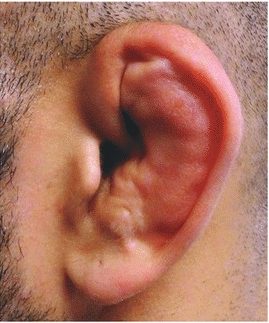Cauliflower ear is quite a common injury in BJJ. In this post I explain what a cauliflower ear is, why jiu jitsu gives you cauliflower ear, how to avoid cauliflower ear in BJJ and how to get rid of it if you do get it.
What is Cauliflower Ear?

Cauliflower ear (also known as perichondrial hematoma or wrestler’s ear) is a deformity of the ear that makes it look lumpy, a little bit like a cauliflower. This deformity occurs when you bruise your ear, causing it to bleed internally and swell up. When this blood thickens, you are left with an ear that is hard and looks permanently swollen.
What causes cauliflower ears?
Cauliflower ear is caused by blunt trauma. This trauma can come in the form of a hard hit to the ear, or a rubbing of the ear against a surface. For example, I’ve seen multiple people get cauliflower ear after their ear folded double while they were trying to slip out of a triangle choke.
Does BJJ give you cauliflower ears?
Yes. In BJJ, it’s possible that someone accidentally hits your ear hard, or that your ear gets trapped and gets rubbed the wrong way. The more stubborn you are, the more likely this is to happen, but it can happen to all of us.
How Common are cauliflower ears in BJJ?
From my experience, about 2% of people that train BJJ get severe cauliflower ear, and about 10% of people get milder forms of cauliflower ear. Of course these incidences are higher when you look at the professional athletes because they train more, and harder, than the rest of us.
How long until you get cauliflower ears in BJJ?
Curiously enough, a lot of people I know got cauliflower ears within their first 3 months of BJJ. I think this is because some people are genetically disposed to it, and they’ll get it right away, while others just never get it.
And, new people sometimes make mistakes that inflict cauliflower ears onto themselves (such as getting their ear stuck in a folded position and not tapping).
Are cauliflower ears bad or dangerous?

Cauliflower ear is a deformity that mostly affects how you look, which can be very important if this matters for your job or your relationships. It can also impair hearing because the shape of your outer ear plays a role in hearing. If left untreated, cauliflower ear is permanent, and once you have some cauliflower ear you are more likely to develop more of it.
How to Avoid Cauliflower Ears in BJJ?
There’s no guaranteed way to prevent cauliflower ear in BJJ, but there’s a number of steps you can take to avoid it.
Tip #1: Adjust your rolling style
Cauliflower ear is definitely more common in people that use pressure passes, and that always use the side of their head to push people down. It’s also more common in people that try to slip their head out of tight spots, such as front headlocks or triangles. You can choose to not do this as much in training, to limit the strain on your ears.
Furthermore, if your ear ever gets stuck in a weird spot, I recommend that you just tap. Then, after you free your ear, you can continue again from the same spot, or just restart. I don’t think it’s worth it in training to tough out a position where you might get yourself cauliflower ear for being stubborn.
Tip #2: Wear Headgear
Plenty of people that train BJJ wear headgear to protect their ears. I personally don’t know anyone who always wears headgear, but I know a lot of people that wear headgear when they feel their ear is sore. I think this is smart, especially if you know that your ears are susceptible to getting bruised.
Tip #3: Wear Specialized ear shields
There’s also new ear shields available that protect your ear from the inside out. How it works is that you make a mold of our own ear, send it to the company, and they send you back a transparent shield that you put inside your ear. This is still a relatively new technology and I don’t know anyone who uses it yet, but it seems promising.
What are early signs of cauliflower ear?

Any pain or swelling to the ear is an early indicator that you might get cauliflower ear. I’ve had small lumps after training 3 times, and they went away after I took a few rest days. You can also protect yourself more when you come back to training by wearing headgear.
Treatment for Cauliflower Ear
The treatment for cauliflower ear is that you drain the blood out of your ears and then compress your ears so that new blood can’t enter.
I’m not a doctor so don’t take this as medical advice, please.
Drain the Ear
Medical professionals can drain your ears, or you can try to do it yourself. Everybody I know does it themselves. I’ve also heard that many medical professionals are surprisingly unfamiliar with cauliflower ear and its treatment.
It’s important that you drain your ears as soon as possible, definitely within 10 days but preferably directly after training. The longer you wait, the thicker the blood in your ear becomes, and the harder it is to drain.
You need to disinfect your whole ear before you drain it to reduce the risk of infections to your ear.
Draining Supply List
- Syringe needle. Get one with a fairly short length but quite a thick diameter (22-24 gauge).
- Rubbing alcohol
- Disposable gloves
- Antibacterial ointment (such as neosporin)
Step by Step draining guide
- Put on disposable gloves and disinfect your whole ear and your equipment with a powerful disinfectant, such as medical alcohol.
- Insert the needle into the center of the swelling, and slowly drain out the blood. You shouldn’t have to pull hard to get the blood out, and you may be surprised by how much blood comes out of your swollen ear.
- Repeat step 2 until the ear is not swollen anymore. You may have to insert the needle into multiple different places, depending on the shape of the swelling.
- After you’re done draining, clean the ear again with water and a disinfectant, and apply an antibacterial ointment to the places where you inserted the needle.
- After draining, apply compression to your ear as soon as possible, so that it can’t fill up with blood again.
How to apply compression to your ear
You need to apply pressure on your ear consistently for at least a week so that the damaged tissue in your ear can heal. You can do this in a number of different ways.
Clips
You can put any kind of clip on your ear. The problem with this is that clips typically only cover a very small surface area, they’re uncomfortable, and they fall off easily while you sleep.
Cauliflower Ear Magnets
Magnets are the preferable way to compress your ears. You can buy special cauliflower ear magnets, or normal magnets and put some athletic tape on them to make them more comfortable.
Normal magnets are a bit cheaper, but you need to make sure that they’re fairly large so that they cover the entire area of the swelling. And they should be strong enough to compress the swelling but not so strong that they crush your ears.
Other useful products for cauliflower ear
I found a few other products for cauliflower ear that I find worth mentioning.
Ear Pillows
Sleeping is a problem when you’re recovering from cauliflower ear. If you have mild cauliflower ear it’s uncomfortable to lay on your ear, and if you’re compressing after draining your cauliflower ear you can’t lay on your ear at all.
If you still want to lay on the side of your cauliflower ear, you can use a pillow with a hole in it. Or, you can use a small overlay pillow with a hole in it on top of your normal pillow. The hole takes the pressure of your ear, allowing you to sleep on that side of your body.
Earcovery Headphones
I found these Earcovery headphones that cool your ears, which reduces swelling and pain in your ears. I haven’t tried them so I don’t know if you can wear them while compressing your ear. But especially for when you have early signs of a cauliflower ear, of just a small bump in your ears, I think this is very useful. (Normally I always cool my ear with an ice pack, but I stop after 20 minutes because it’s too annoying to do.)
Can you train BJJ while you have Cauliflower Ear?
If you recently drained your ears to remove cauliflower ear, you shouldn’t train for 1 or 2 weeks. If you only have a small lump on your ear and you didn’t train it, you should judge for yourself when you can train again, and it’s advisable to wear headgear until the swelling is gone..
